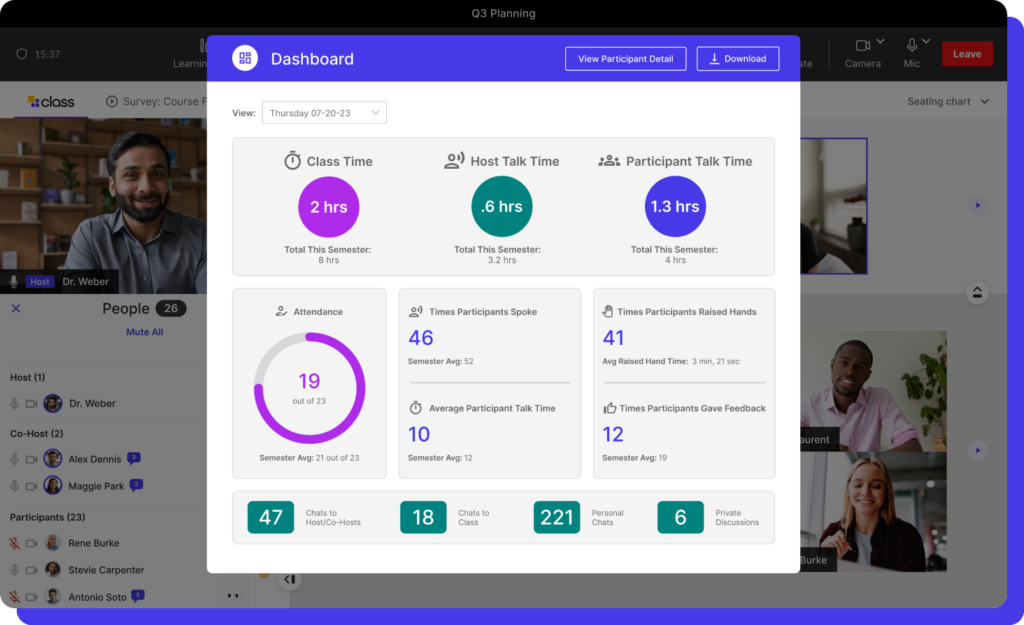
Eric Hansen works as an Account Executive for Class. He is passionate about education technology and helping others learn. When not working, he loves spending time in the Utah mountains, mountain biking, fly fishing and camping with his family.

Eric Hansen works as an Account Executive for Class. He is passionate about education technology and helping others learn. When not working, he loves spending time in the Utah mountains, mountain biking, fly fishing and camping with his family.

Modern technology allows us to measure and analyze much more than we’ve previously been able to. With this power at our fingertips, we can glean insights from hard data to make changes in real time, reaching our goals with an efficiency that’s been previously unmatched.
And while this wasn’t an option in the past, the ability to accurately measure the impact of virtual training programs is a very real possibility. When put to use properly, this kind of measurement is a catalyst for change in industries like healthcare, financial services, consulting, manufacturing, and others that rely heavily on impactful training programs.
But the ability to measure doesn’t guarantee success. You also need to know what metrics to track, how to avoid bias, and how to get buy-in from stakeholders and instructors.
Let’s examine how best to use data and automation to save instructors and administrators time and improve the learner experience.
While there are several things to consider when implementing the most effective measurement program for virtual training, let’s take a closer look at three top challenges that we recommend tackling first, as well as our tips for clearing these hurdles with ease.
We’ve established that the introduction of data to quantify learner engagement is key to properly measuring the effectiveness of virtual training programs. But taking this a step further, how do you then take that data and use it to actually improve your training programs?
First, you can use technology that helps you quantify both session-wide data as well as individual learner data. As we touched on above, you can assess various metrics using a data-driven virtual education program, like total class time, instructor speaking time, participant speaking time—including the total number of times participants spoke as well as the average speaking time from all participants, and the total number of times participants raised their hands or gave feedback through the platform.
Look for a solution that compiles all of these metrics into one easy-to-digest dashboard and allows you to view results for an entire session, as well as drill down into individual participant results. Use the insights from your results to inform the changes you make to your training programs, and continue to iterate as more results come in.
Technology can also automate time-consuming tasks like attendance recording, time in, time out, and tardiness, which both increases the accuracy of this data and frees instructors up to focus on quality education, improving the learning experience overall.
If you’re trying to effect change in your training programs by determining what’s working and not working, having quantifiable results and trends can go a long way in showing stakeholders the impact. Remember to utilize automation in your reporting technology, which can help expand reporting efforts and demonstrate effectiveness at a larger scale.
When you’re communicating the value of your reporting to stakeholders, it also helps to have a framework for your metrics that’s backed by research and proven success. The Kirkpatrick Model for evaluating learner engagement lends itself perfectly here. This model distills training evaluation down to four distinct levels:
Make sure whatever metrics you’re tracking to measure effectiveness follow a similar model to the Kirkpatrick Model. The key is persistent tracking to evaluate success at several points in time, allowing you to present a complete picture with your results.
Access to accurate data and smart automation is the backbone of a successful training program. This powerful combination of tools ensures that you can always keep your finger on the pulse of how your programs are performing, and allows you to focus on innovating and providing the best possible education for your learners.

Class helps you automatically report on key engagement metrics, monitor attendance interactions, segment data by class or individual learner, and download CSV files for flexible data management. In addition to powerful analytics to gauge the effectiveness of your training programs, Class’s enhanced LMS integrations allow organizations to launch live synchronous sessions directly from their LMS, providing in-session access to LMS content and syncing progress back.
See how you can take advantage of reliable analytics and simple yet powerful automations to improve your online training courses. Speak with a Class expert today.

Eric Hansen works as an Account Executive for Class. He is passionate about education technology and helping others learn. When not working, he loves spending time in the Utah mountains, mountain biking, fly fishing and camping with his family.

Eric Hansen works as an Account Executive for Class. He is passionate about education technology and helping others learn. When not working, he loves spending time in the Utah mountains, mountain biking, fly fishing and camping with his family.
Get our insights, tips, and best practices delivered to your inbox

Sign up for a product demo today to learn how Class’s virtual classroom powers digital transformation at your organization.

Features
Products
Integrations